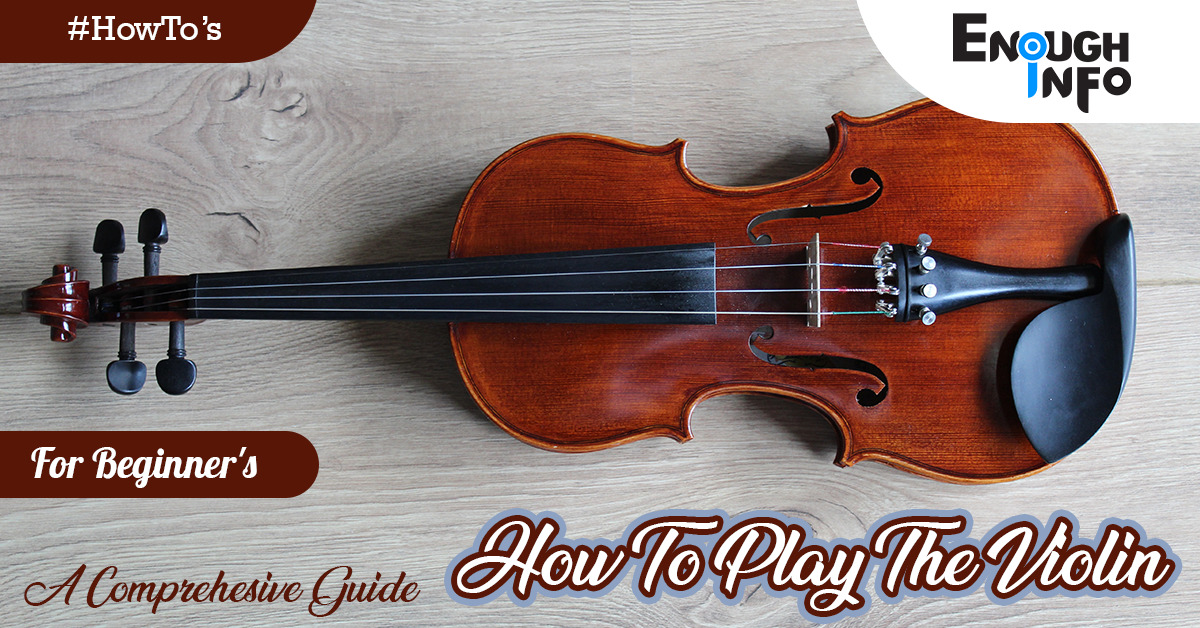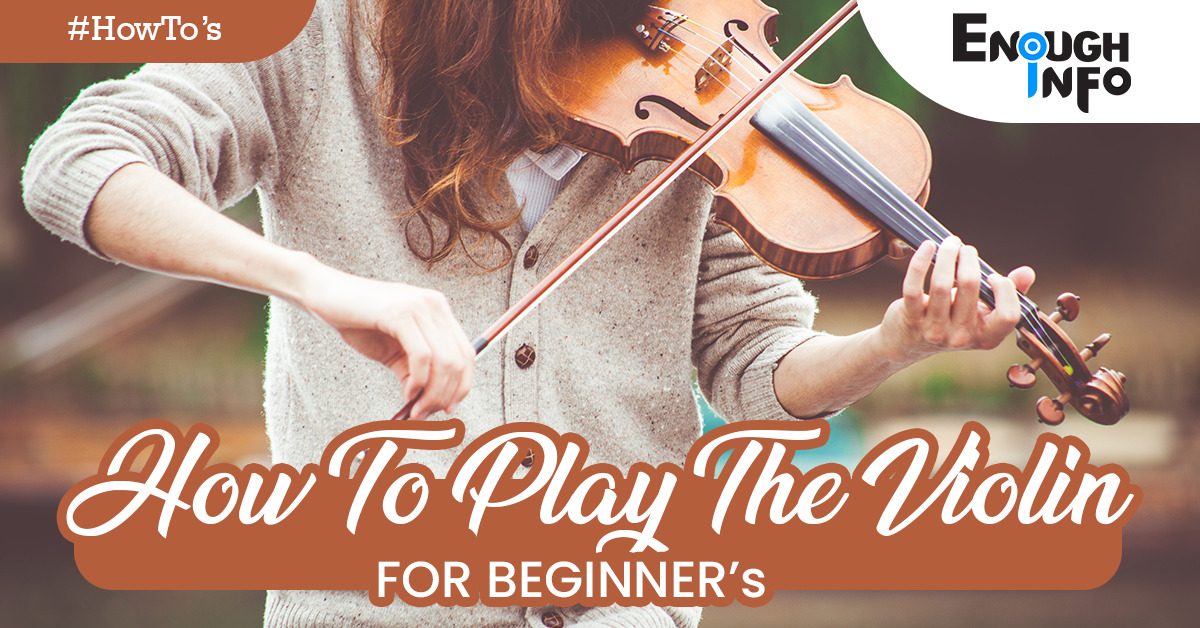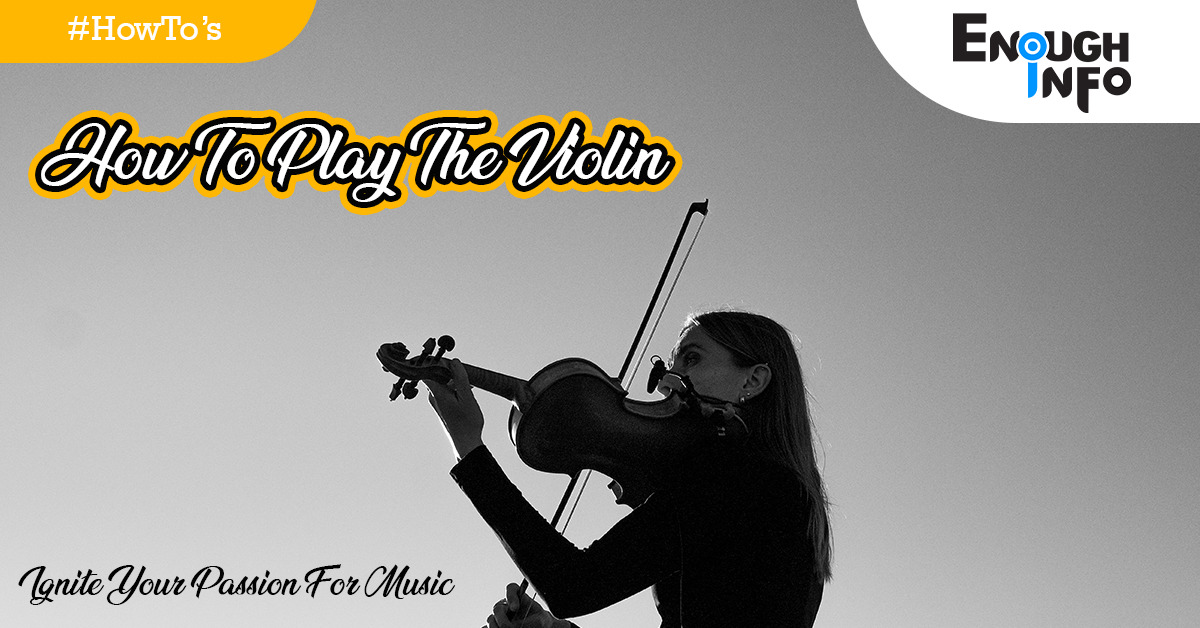
How To Play The Violin For Beginners: The violin is a beautiful and versatile instrument that has captured the hearts of music lovers for centuries. Whether you dream of playing classical masterpieces or exploring other genres, learning the violin is a rewarding and fulfilling journey. The violin is known for its expressive capabilities, allowing players to convey a wide range of emotions through their music. Learning to play the violin gives you the opportunity to express yourself artistically and communicate through the language of music. EnoughInfo.com

Learning how to play the violin as a beginner is important not only for the musical skills it imparts but also for the cognitive, emotional, and personal development it nurtures. It is a fulfilling and rewarding endeavor that opens a world of music and self-expression. So, pick up the violin, embrace the challenges and joys of learning, and embark on a musical journey that will enrich your life in countless ways. How To Do Basic Home Repairs
Read Also: How To Play The Flute For Beginners
FAQs & Answers on How to Play the Violin for Beginners
1. How long does it take to learn the violin?
Learning the violin is a journey that varies for each individual. It depends on factors such as practice consistency, dedication, natural aptitude, and previous musical experience. With regular practice and proper guidance, beginners can start playing simple tunes within a few months. How To Make Homemade Natural Cleaning Products
2. Can I teach myself to play the violin?
While self-teaching is possible, it’s highly recommended to seek guidance from a qualified violin teacher, especially in the early stages. A teacher can provide proper technique instruction, address any bad habits, and guide you through the learning process.
3. How often should I practice the violin?
Consistency is key. Aim to practice the violin for at least 30 minutes to an hour each day. Regular practice helps build muscle memory, develop technique, and progress more efficiently.
4. How do I care for my violin?
Proper care and maintenance are essential for the longevity and performance of your violin. Keep the instrument in a protective case when not in use, wipe it down after playing, and have it regularly inspected by a luthier for adjustments and maintenance.
5. Should I learn to read sheet music?
Yes, learning to read sheet music is essential for violin players. It allows you to interpret and perform a wide range of music accurately. Start by familiarizing yourself with basic musical notation and gradually progress to more complex pieces.
Read Also: How To Play The Piano Without Reading Sheet Music
How to Play the Violin for Beginners: A Comprehensive Guide

If you’re a beginner eager to embark on this musical adventure, this comprehensive guide will provide you with the essential steps, techniques, and tips to start playing the violin. How To Do Basic Car Painting (All You Need To Know)
Would you like to learn to play the violin? Maybe you’ve always wanted to be a fantastic violinist. Do you want to know what you need to know or do to accomplish this goal? If you want to get out on the right foot when learning to play the violin, start with the correct equipment. It’s far easier said than done. With so many options available, choosing the correct violin for you might be difficult. Take your time, as this is a significant decision.
The first few years of learning to play the violin can be challenging. When you commence on this trip, a high-quality violin will make a great sound and be easier to play, encouraging you and assisting your success. On the other hand, a low-quality violin with a terrible sound that is difficult to play can discourage students, who may not want to play at all as a result!
Choosing the Right Violin:
Before you begin your violin journey, it’s essential to choose the right instrument that suits your needs and budget. Consider the following factors when selecting a violin:
Renting vs. Buying a Violin: For beginners, renting a violin is often a practical and cost-effective option. It allows you to try different instruments without a significant financial commitment. However, if you’re committed to learning the violin long-term, buying a violin might be a better investment. How To Create A Budget For Traveling
Sizing the Violin: Violins come in various sizes, and it’s crucial to choose the appropriate size for your body. Adult beginners typically use a full-size (4/4) violin, while younger students may require smaller sizes. Consult with a violin teacher or a professional at a music store to determine the correct violin size for you.
Read Also: How To Play The Ukulele (For Beginners)
Essential Accessories:
Besides the violin itself, there are several essential accessories you’ll need:
- Bow: Choose a bow that is in good condition, with proper tension and horsehair.
- Rosin: Rosin is applied to the bow hair to create friction and produce sound.
- Shoulder Rest: A shoulder rest helps support the violin and improves comfort while playing.
- Tuner: A tuner helps you tune your violin accurately. How To Make A DIY Face Mask For Glowing Skin
- Case: Invest in a sturdy and protective case to safeguard your violin when not in use.
Proper Violin Hold and Posture:
Developing the correct violin hold and posture is crucial for comfortable playing and avoiding strain or injury.
1. Holding the Violin:
- Stand with your feet shoulder-width apart and maintain a relaxed stance.
- Hold the violin with your left hand by placing your thumb near the lower edge of the fingerboard and lightly gripping the neck.
- Rest the violin’s chinrest against your chin and left shoulder, with the chinrest supporting the weight of the instrument.
2. Positioning the Left Hand:
- Curve your left-hand fingers and place them on the fingerboard.
- Each finger should press down on the string, creating clear notes without touching neighboring strings.
- Maintain a relaxed and rounded hand shape, avoiding excessive tension.
3. Correct Bow Hold:
- Hold the bow with your right hand using the following steps: a. Place the bow on your open palm, allowing the frog (the bottom part of the bow) to rest near the base of your thumb. b. Curve your fingers around the bow, placing your thumb on the side of the frog. c. Rest your pinky on top of the bow, creating a balanced and relaxed grip. d. The bow should rest between the first and second finger joints, allowing for flexibility and control. How To Teach A Parrot To Talk
Learning Basic Techniques:
To produce beautiful sounds on the violin, you’ll need to learn and practice fundamental techniques.
1. Bowing Techniques:
- Begin with long, slow bow strokes on open strings to develop a consistent sound.
- Experiment with different bowing techniques, such as legato (smooth and connected), staccato (short and detached), and spiccato (bouncing bow).
- Focus on maintaining a straight bow trajectory and even pressure across the strings.
2. Finger Placement and Positioning:
- Learn the placement of each finger on the fingerboard to produce specific notes.
- Practice shifting your fingers along the fingerboard to reach different positions.
- Develop finger independence and agility by practicing finger exercises and scales.
3. Reading Sheet Music:
- Familiarize yourself with musical notation, including notes, rhythms, and other musical symbols.
- Learn to read sheet music specifically written for the violin, including treble clef and key signatures.
- Start with simple melodies and gradually progress to more complex pieces.
Practicing Scales and Exercises:
Scales and exercises are fundamental for developing technique, finger strength, and coordination.
1. Major and Minor Scales:
- Begin with the major scales, starting with the key of G major, which uses open strings.
- Gradually learn other major scales, both in one octave and extended positions.
- Progress to practicing minor scales, focusing on natural, harmonic, and melodic minor scales.
2. Bowing Exercises:
- Practice bowing exercises to improve bow control, such as longbows, detach, and spiccato exercises.
- Incorporate string crossings, bow direction changes, and dynamics into your exercises.
3. Shifting and Vibrato Exercises:
- Explore shifting techniques to move between positions smoothly.
- Develop vibrato by practicing exercises that focus on finger motion and wrist flexibility.
Read Also: How To Be Better At Something
Playing Simple Melodies:

Once you have grasped the basic techniques, start playing simple melodies and tunes.
1. Playing Open Strings:
- Begin by playing melodies using open strings only.
- Focus on producing a clear and resonant sound on each string.
2. Simple Songs and Tunes:
- Progress to playing simple songs and tunes that incorporate fingerings and basic techniques.
- Start with familiar melodies and gradually move on to more challenging pieces.
Developing Rhythm and Timing:
Rhythm and timing are crucial for musicality and ensemble playing.
1. Understanding Time Signatures:
- Learn to read and understand time signatures, such as 4/4, 3/4, and 2/4.
- Practice counting beats and subdivisions to develop a sense of rhythm.
2. Metronome Practice:
- Utilize a metronome to practice playing in time and maintaining a steady tempo.
- Start with a slower tempo and gradually increase the speed as you become more comfortable and accurate.
3. Playing with Accompaniment:
- Play along with backing tracks or recordings to develop your sense of timing and ensemble skills.
- Experiment with different musical styles and genres to broaden your musical repertoire.
Expanding Your Repertoire:
As you progress, it’s important to explore a wide range of music to expand your repertoire.
1. Classical Pieces:
- Explore classical violin repertoire from different periods, including Baroque, Classical, Romantic, and Contemporary.
- Start with simplified arrangements and gradually tackle more advanced compositions.
2. Folk Music:
- Dive into the rich tradition of folk music from various cultures. How To Play The Flute For Beginners
- Learn popular folk tunes and traditional melodies, incorporating techniques such as slides, drones, and double stops.
3. Contemporary Music:
- Explore modern compositions and popular songs adapted for the violin.
- Experiment with different playing styles and techniques, such as pizzicato, harmonics, and glissandos.
Tips for Effective Practice:
To make progress in your violin journey, follow these tips for effective practice:
1. Establishing a Practice Routine:
- Set aside dedicated practice time each day or week.
- Break your practice sessions into manageable chunks focusing on different aspects, such as scales, exercises, and repertoire.
2. Breaking Down Difficult Passages:
- Identify challenging sections in your music and break them down into smaller parts.
- Practice each segment slowly and gradually increase the tempo as you gain confidence and accuracy.
3. Seeking Guidance and Feedback:
- Consider taking lessons from a qualified violin teacher who can provide guidance, correct technique, and offer constructive feedback.
- Attend workshops, masterclasses, and participate in ensemble playing to broaden your musical horizons.
Read Also: How To Play the Guitar For Kids
Conclusion:
Learning to play the violin as a beginner requires patience, dedication, and a consistent practice routine. By following the steps outlined in this comprehensive guide, you can develop proper technique, build a strong foundation, and progress in your musical journey. Remember to seek guidance from a qualified teacher, practice regularly, and have fun exploring the beautiful world of violin music. Enjoy the process and embrace the joy of making music with this enchanting instrument.
Recommended;
How to write a persuasive essay for school
How To Play Chess For Beginners
Improving Your Gaming Skills in First-Person Shooter Games




